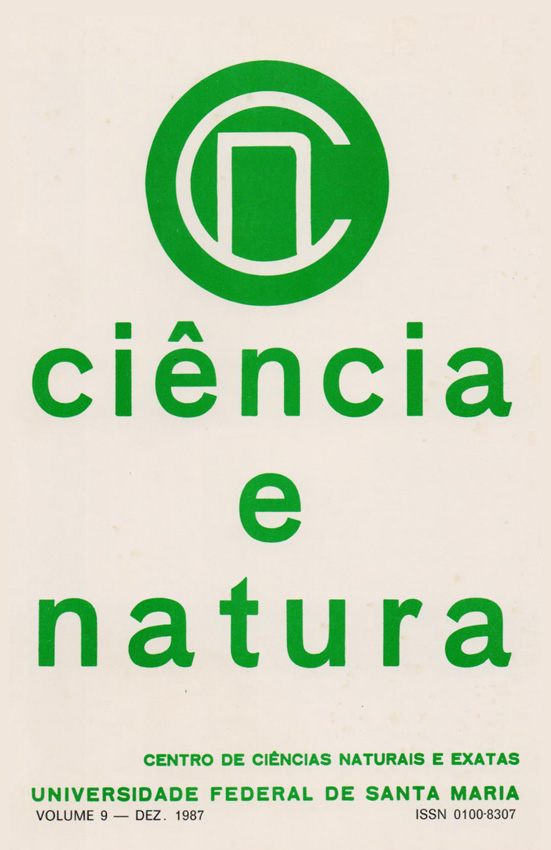Aspectos da estrutura foliar de Stevia cinerascens Sch. - Bip. (Compositae)
DOI:
https://doi.org/10.5902/2179460X25475Resumo
Folhas de plantas de Stevia cinerascens, com cheiro agradável (amostra A) e sem perfume (amostra B), que apresentam diferença de porte e se desenvolve em condições ambientais diferentes, foram objeto de presente trabalho. Estudou-se a arquitetura foliar em folhas clarificadas e a anatomia em cortes de material vivo ou fixado. Determinou-se a área ocupada pelas células epidérmicas, estômatos e tricomas segundo método estereológico. Nessas plantas, as folhas têm estrutura dorsiventral, são anfiestomáticas com estômatos anomocóticos. Os tricomas são simples - cônico e filiforme - e glandulares bisseriados vesiculares. A venação é acródroma. Os feixes vasculares são colaterais, sendo que os feixes menores do mesofilo apresentam bainha parenquimática. Os elementos de vaso têm placa de perfuração simples. Canais secretores esquizógenos ocorrem nas nervuras primárias e ocasionalmente nas secundárias. O tecido de sustentação é o colênquima que ocorre ao longo das nervuras maiores. As folhas das amostras A e B se destinguem estruturalmente pela diferenciação dos tricomas glandulares bisseriados, subtipo alfa (amostra A) beta (amostra B), e por caracteres frequentes em folhas de sol (amostra A) e de sombra (amostra B).Downloads
Referências
CUTTER, E. Plant anatomy: experiment and interpretation, London, Addison-Wesley Publ., v.2, 1971. 343 p. il.
CUTTER, E. Plant anatomy, Part I Cells and tissues. 2.ed., Great Britain, Edward Arnold, v.1, 1978. 315 p. il.
ESAU, K. Anatomy of seed plants, 2.ed., New York, John Wiley & Sons, 1977. 550 p. il.
FAHN, A. Plant anatomy. Oxford, Pergamon Press, 1972. 534 p. il.
FOSTER, A.S. Techniques for study of venation patterns in the leaves of Angiosperms. In: International Congress, 7,Stockolm, 1950. Proceedings... Stockolm, 1953:586-7.
HICKEY, L.J. Classification of the architecture of dicotyledoneous leaves. Am. J. Bot. 60(1):17-33,1973.
IFJU, G. Quantitative wood anatomy - a stepeological approch. Blacksburg, VPI, IPT, 1977. 26 p.
JOHANSEN, D.A. Plant microtechnique, New York, Mc Graw-Hill Book, 1940. 523 p.
MONTEIRO, R. Estudos taxonômicos em Stevia série Multiaristatae no Brasil. Revta brasil. Bot. 5:5-15,1982.
RAMAYYA, N. Studies on the trichomes of some Compositae. I General structure. Bull. Bot. surv. India. 4(1-4):177-88, 1962.
Downloads
Publicado
Como Citar
Edição
Seção
Licença
Para acessar a DECLARAÇÃO DE ORIGINALIDADE E EXCLUSIVIDADE E CESSÃO DE DIREITOS AUTORAIS clique aqui.
Diretrizes Éticas para Publicação de Revistas
A revista Ciência e Natura está empenhada em garantir a ética na publicação e na qualidade dos artigos.
A conformidade com padrões de comportamento ético é, portanto, esperada de todas as partes envolvidas: Autores, Editores e Revisores.
Em particular,
Autores: Os Autores devem apresentar uma discussão objetiva sobre a importância do trabalho de pesquisa, bem como detalhes e referências suficientes para permitir que outros reproduzam as experiências. Declarações fraudulentas ou intencionalmente incorretas constituem comportamento antiético e são inaceitáveis. Artigos de Revisão também devem ser objetivos, abrangentes e relatos precisos do estado da arte. Os Autores devem assegurar que seu trabalho é uma obra totalmente original, e se o trabalho e / ou palavras de outros têm sido utilizadas, isso tem sido devidamente reconhecido. O plágio em todas as suas formas constitui um comportamento publicitário não ético e é inaceitável. Submeter o mesmo manuscrito a mais de um jornal simultaneamente constitui um comportamento publicitário não ético e é inaceitável. Os Autores não devem submeter artigos que descrevam essencialmente a mesma pesquisa a mais de uma revista. O Autor correspondente deve garantir que haja um consenso total de todos os Co-autores na aprovação da versão final do artigo e sua submissão para publicação.
Editores: Os Editores devem avaliar manuscritos exclusivamente com base no seu mérito acadêmico. Um Editor não deve usar informações não publicadas na própria pesquisa do Editor sem o consentimento expresso por escrito do Autor. Os Editores devem tomar medidas de resposta razoável quando tiverem sido apresentadas queixas éticas relativas a um manuscrito submetido ou publicado.
Revisores: Todos os manuscritos recebidos para revisão devem ser tratados como documentos confidenciais. As informações ou ideias privilegiadas obtidas através da análise por pares devem ser mantidas confidenciais e não utilizadas para vantagens pessoais. As revisões devem ser conduzidas objetivamente e as observações devem ser formuladas claramente com argumentos de apoio, de modo que os Autores possam usá-los para melhorar o artigo. Qualquer Revisor selecionado que se sinta desqualificado para rever a pesquisa relatada em um manuscrito ou sabe que sua rápida revisão será impossível deve notificar o Editor e desculpar-se do processo de revisão. Os Revisores não devem considerar manuscritos nos quais tenham conflitos de interesse resultantes de relacionamentos ou conexões competitivas, colaborativas ou outras conexões com qualquer dos autores, empresas ou instituições conectadas aos documentos.






